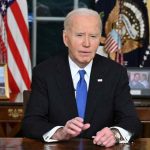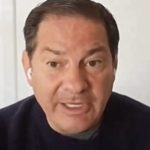One of the issues addressed in the recent Colorado Supreme Court decision holding that Donald Trump is disqualified from becoming president again under Section 3 of the Fourteenth Amendment is whether Section 3 applies to the presidency. A key reason to think it does apply is that ruling otherwise would lead to absurd results. As the Colorado ruling puts it, “President Trump asks us to hold that Section Three disqualifies every oath-breaking insurrectionist except the most powerful one and that it bars oath-breakers from virtually every office, both state and federal, except the highest one in the land.” That sure seems absurd to me! And longstanding precedent disfavors interpretations that lead to absurd results.
In a recent Slate article, Harvard law Prof. Larry Lessig argues that excluding the president from Section 3 is not absurd. But his reasoning ultimately reinforces the very point he is trying to dispute.
Lessig’s main argument is that the presidency and vice presidency are unique because state officials barring presidential and VP candidates from the ballot create an “externality”:
[T]here is an obvious reason why the only two nationally elected officers would be excluded from its reach. It took mere moments after the Colorado Supreme Court’s ruling to see why, as Texas Lt. Gov. Dan Patrick threatened to remove President Joe Biden from the Texas ballot as retribution. You see, with every other officer excluded under the provision, the state official or state court effecting that exclusion would feel the political costs of their decision alone. If the Missouri secretary of state decides that Josh Hawley was an insurrectionist — for both advancing a plainly illegal theory under which Congress could reverse the electoral votes of Pennsylvania, and for rallying the rioters on Jan. 6 with his now-infamous salute — then Missouri and its voters will bear the political costs of that decision alone. Its act would not impose a cost on other states. But if state officials from blue states can remove red state candidates, or vice versa, that state bears no cost. Instead, it gains a political victory. In the language of economics, the decision imposes an externality on the nation, which is exactly the kind of decision that states alone should not be making for other states. Such behavior is obvious to lead to a tit for tat and a breakdown of our entire electoral system.
Lessig ignores the fact that presidential candidates are far from the only ones whose exclusion has an effects beyond the borders of their state. The same applies to members of Congress. They vote on legislation that applies to the entire country. If Missouri excludes Hawley from the ballot, and a Democrat gets elected senator as a result (or a less MAGA Republican), that impacts the entire nation, not just one state. MAGA Republicans across the country might lose out, not just those in Missouri.
If you object to excluding insurrectionist candidates because doing so might create externalities like this, that’s not an argument for exempting the president. It’s an argument against having Section 3 at all.
It’s true, of course, that partisan state officials could try to manipulate Section 3 to advantage their party. But that’s why Section 3 exclusions—like other electoral qualification decisions—are subject to judicial review. If state officials try to bar someone who is not actually disqualified under Section 3, that candidate can sue to overturn their decision.
It’s also worth emphasizing that the purpose of Section 3 is to prevent a different kind of externality from the type that concerns Lessig: having potentially dangerous former insurrectionists wield political power. If voters—perhaps due to ignorance or partisan bias – elect such people to public office, the harm these officials might do will affect not only those who voted for them, but the rest of the country as well. Insurrectionists in office could prove to be a menace to liberal democracy throughout the nation. The enactment of Section 3 was based on the assumption that preventing this kind of extremely dangerous externality was worth the cost, including other possible externalities that cut the opposite way.
Lessig’s externality theory is at odds with the fundamental reason why Section 3 was enacted in the first place. Excluding the presidency from Section 3 on the basis of arguments that imply we shouldn’t have Section 3 at all doesn’t make any sense. It would, in fact, be absurd.
Lessig also argues the framers of the Amendment didn’t need to worry about former insurrectionists becoming president because Section 3 ensures that presidential electors will be loyal, since it specifically bars insurrectionists from that position, thereby ensuring that “the people who would elect the president were not themselves insurrectionists.” I explained why this argument (previously advanced by Kurt Lash) is fallacious here:
This argument ignores the possibility than an insurrectionist former president could still potentially hold other offices, such as being a member of Congress or serving as a member of the cabinet…
In addition, there was no reason to think that electors would necessarily abjure supporting former insurrectionists for the presidency. Since Section 3 only covers former government officials of various kinds, ex-Confederates who had not held public office previously (of which there were hundreds of thousands) could still become members of the Electoral College—and some actually did. Furthermore, by 1868 (as still today), electors were almost always little more than ciphers for their parties, who could be reliably expected to support the party’s nominee no matter what. It is highly unlikely that committed partisan Democrat electors (most former Confederates backed the Democratic party in the years after the war) would forgo supporting a former Confederate insurrectionist for the presidency if he were the nominee of their party.
Given how the electoral college worked by the 1860s and the ability of many ex-Confederates to become electors, it is implausible to assume that the president was excluded from Section 3 on the theory that electoral college would prevent ex-insurrectionists from getting to the White House.
Lessig also contends (again, following Lash) that Section 3 was supposed to apply only to Civil War-era insurrectionists, and there was no danger of one of them becoming president. But the text of the amendment is general, and in no way limited to Civil War insurrectionists alone. Moreover, in the 1860s, the Democratic Party was one of the two major parties, and it drew much of its support from ex-Confederate white southerners. Absent Section 3, there was every reason to think such a person could potentially win the Democratic nomination for president. And any winner of a major-party nomination has at least some plausible chance of winning the general election.
The absurdity argument is far from the only reason why courts should conclude that the presidency is covered by Section 3. I think the “ordinary meaning” rule, emphasized in the Colorado Supreme Court ruling, is even more compelling. But the absurdity point is also strong. Indeed, the two are mutually reinforcing. An ordinary person reading Section 3 would be unlikely to interpret it in a way that leads to absurd results, especially if there is a plausible non-absurd alternative.
The post Efforts to Show that Exempting the President from the Scope of Section 3 of the 14th Amendment isn’t Absurd Underscore that it Actually is appeared first on Reason.com.






